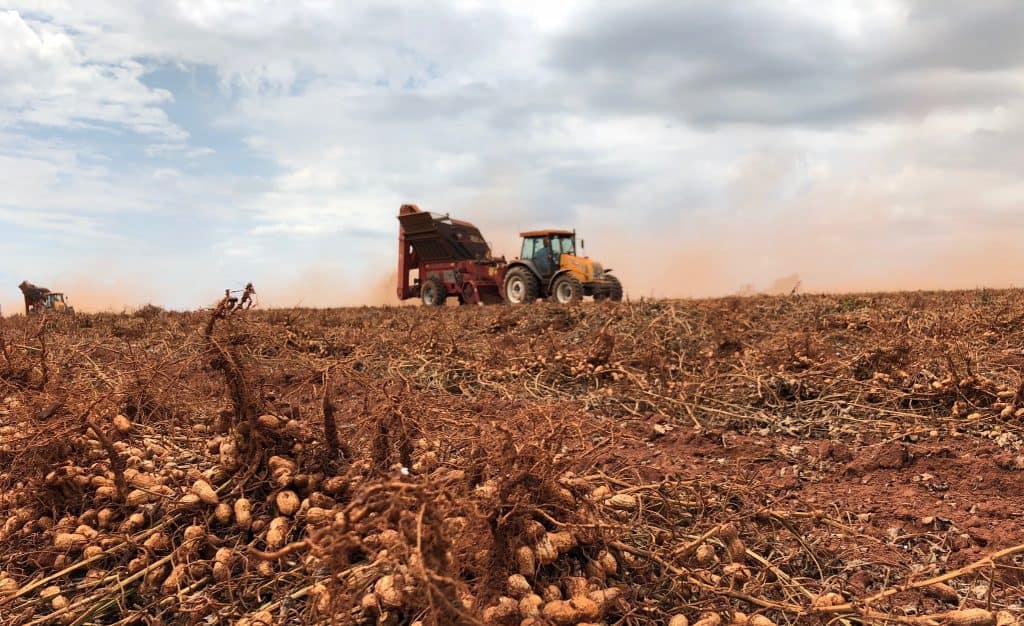Delayed peanut plantings in South America, harvest on the way in the US and decent crops expected in Asia. Herman Driesens, manager at Amberwood Rotterdam, regularly publishes peanut market updates on LinkedIn. The below is an overview of their findings in October 2020. The peanut market has proved to be very erratic in a world meanwhile controlled or dictated by a pandemic!
With Argentine shellers very well sold, and Brazil totally of the market being basically sold out on current crop and with new crop plantings already delayed with 3 or 4 weeks due to lack of rain, one should wonder where buyers who are not covered yet should buy their peanuts from now until April/May next year.
Of course it helps that the US recently estimated a 3,347,810 short tons crop (= 3,037,082 metric tons) but we have to keep in mind that the USA was in need of a big (and more important) good quality crop after the disaster of the 2019 crop.
China’s new crop is supposed to be in between 0 and 5% bigger than last year but harvest was delayed due to rain, especially in Northeast China (Liaoning/Jilin) where EU spec material normally originates from.
Good 2020 crop, record high shipments but little rainfall in Argentina
The 2020 crop in Argentina proved to be of very good quality with the only disadvantage being that the crop produced more splits than usual, as a result of very dry harvesting conditions.
The volume available for export will be more or less the same as last season thanks to 10% better yields. As mentioned, Argentina is already very well sold with record high shipments/exports per month (over 55,000 mtons from May onwards). With demand picking up after a few very slow months, prices for blanched 38/42 rapidly increased from USD 1450/1475 to, where we are now, USD 1575/1600 CFR EMP basis. With less availability of whole kernels compared to previous years it would not surprise Amberwood if Argentina will soon be sold out on the whole grades. Besides the usual demand from Europe, we have also seen the USA (blanched), Brazil and China (raw high oleic) buying peanuts from Argentina in the past 2 / 3 months.
During the last 5 months, Argentina has only received very little rainfall. In the region of Córdoba, where most of the peanuts are planted, it impacted heavily the winter crops. The impact of this winter’s drought is still felt despite the recent little rainfalls.
Although there is still time for Argentine shellers to plant their 2021 crop, the current drought and the presence of La Niña does not presage that much rain will be coming along the way in the coming months. A delay in planting in Argentina can create difficulties when it is time to harvest. Luckily, last week a few inches of rain allowed to plant the first peanuts and more rainfall is forecasted in the week to come.
High prices & delayed plantings in Brazil
The market in Brazil has gone through the roof. Next to increased demand for peanut oil and record high exports of raw/blanched peanuts (over 200,000 mtons of 2020 crop from April through to September 2020) the local farmer stock market price has more than doubled since March/April. This explains the fact that Brazilian manufacturers started to buy (cheaper) Argentine peanuts recently.
In the meantime, drought is becoming a real issue. Plantings are already late by 3 to 4 weeks. Some areas around Tupã and the state of Mato Grosso do Sul received some rain this week, allowing to plant some of the first peanuts. But other areas are still very dry, and it is likely that the increase of 5 to 10% of the planting area will be difficult to achieve this year.
With both Brazil and Argentina being delayed, it also means availability of the 2021 crop will most likely be later than usual; meaning buyers will be more depending on anything still available out of the current crop.
Decent crop & large demand from China
China, with having a decent crop themselves, has been buying large quantities of US farmer stock next to peanuts from Senegal, Sudan (until the export ban) and Argentina. Nevertheless, prices in China have been relatively high throughout the season. It feels like consumption in China is still growing steadily. Demand for Chinese peanuts for exports is, on the other hand, also decreasing due to price and changed interest from mainly EU buyers.
The new crop is expected to be around 5% bigger than last year. Although the quality seems to be OK in general, there is concern that the continuous rainfall has affected maturity and growth of kernels.
In the past few weeks, a lot of rumors were going around about the tax refund on blanched peanuts being cancelled, which could increase the price of blanched peanuts with 13%. As per information Amberwood received earlier last week, it looks like the tax refund policy will stay in place.
Delayed harvest, but good quality & quantity crop forecasted in the United States
Despite harvesting being delayed, it looks like the USA will have a big and good quality crop. Ongoing rainfall and flooding (as a result of the various devastating hurricanes, and lower temperatures) will have some impact on final yields and quality, but the majority seems to be of good quality with no real aflatoxin issues, which is a major relief. Hopefully, the (delayed) crop can be harvested fast from now on with no further delays because of hurricanes/rain.
Shellers have been extremely cautious in offering 2020 crop (even until now) until they know what quality they have to deal with. So far, it seems OK as mentioned. With the situation in Brazil and Argentina in mind, the USA should be able to increase exports to the EU if they so desire. Especially on raw but even on blanched Amberwood believe’s they can be competitive.
Lower yields but increased plantings in India
India is or was expecting a huge crop thanks to increased plantings and higher yields. Heavy rains and flooding are having a negative impact on the total crop but it seems very difficult to say to which extend. The expected bigger crop has not led to lower prices for peanut oil thanks to China who imported over 50,000 mtons in just 2 months, and more demand is there. We probably need several weeks to receive more information from India on the size and the quality of the crop.
Large demand from South Africa?
South Africa is basically sold out and will most likely need to import a (probably) significant quantity of peanuts from various origins, but most likely Argentina.




 Westplein 58
Westplein 58



 We use cookies to ensure you get the best experience on our website. For more information, please read our
We use cookies to ensure you get the best experience on our website. For more information, please read our